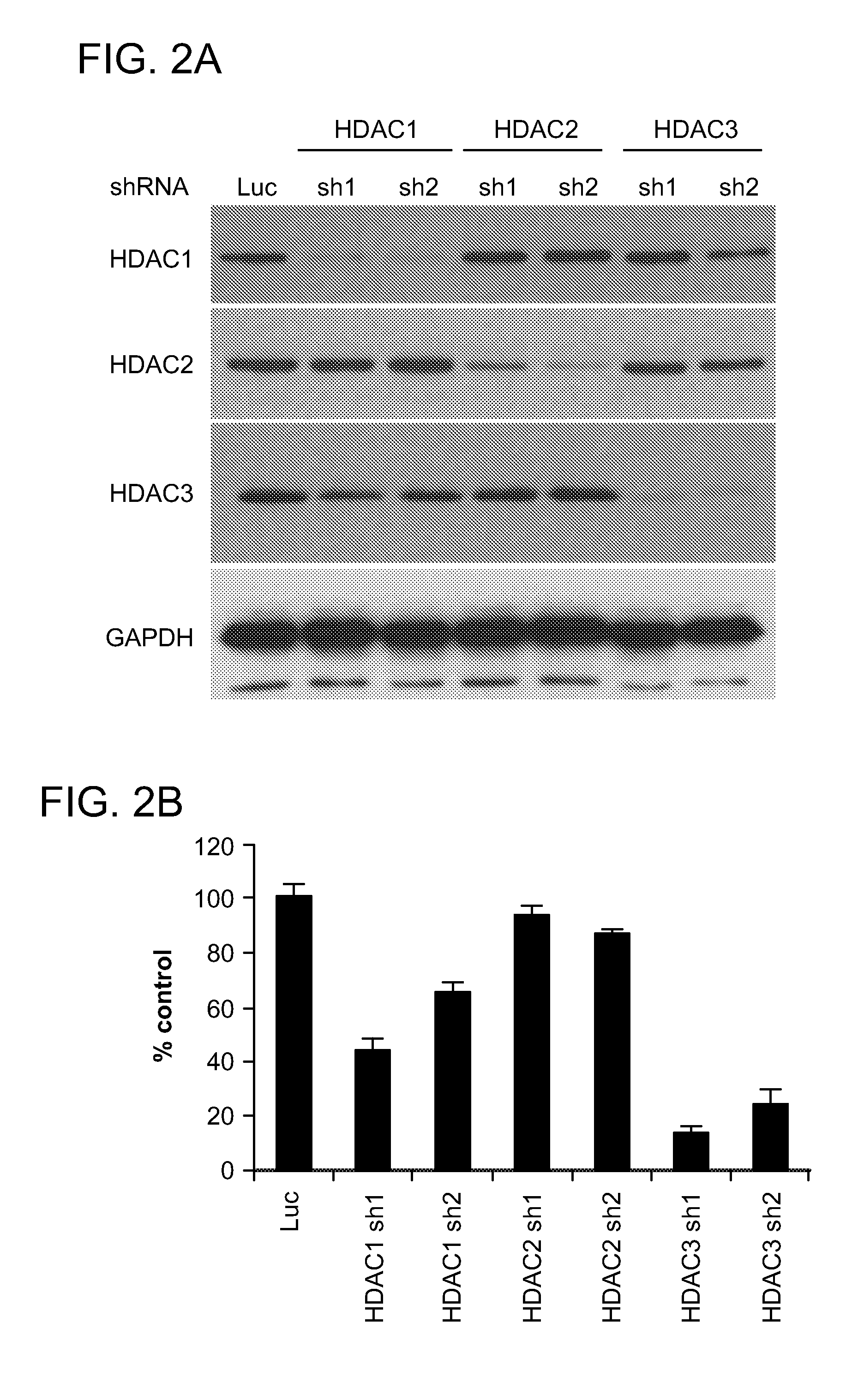Inhibitors of histone deacetylase
a technology of histone deacetylase and inhibitors, which is applied in the field of inhibitors of histone deacetylase, can solve the problems of mm's genetic complexity and molecular heterogeneity, and clinical trials with non-selective hdac inhibitors (hdaci) have shown efficacy
- Summary
- Abstract
- Description
- Claims
- Application Information
AI Technical Summary
Benefits of technology
Problems solved by technology
Method used
Image
Examples
example 1
[0421]Various methods known in the art can be used for carrying out the present invention. Without limiting the present invention, several experimental methods are described below.
[0422]Reagents
[0423]HDAC inhibitors LBH589 (panobinostat), MS275 (entinostat), and tubastatin-A were purchased from Selleck Chemicals (Houston, Tex.). Bortezomib was also obtained from Selleck Chemicals. Compound 10 (N-(2-aminophenyl)pyrazine-2-carboxamide) and Merck60 (4-acetamido-N-(2-amino-5-(thiophen-2-yl)phenyl)benzamide) (see, e.g., Methot et al. Bioorg. Med. Chem. Lett. 2008. 18(3):973-8) were synthesized in house (Massachusetts General Hospital, Cambridge, Mass.). Human recombinant Interleukin (IL)-6 was purchased from R&D Systems (Minneapolis, Minn.).
[0424]Cells
[0425]RPMI8226 and U266 human MM cell lines, as well as human embryonic kidney 293T cells, were obtained from American Type Culture Collection (ATCC, Manassas, Md.). MM.1S cells were provided by Dr. Steven Rosen (Northwe...
example 2
Toxicity of MS275 and Merck60 in MM Cells
[0438]Non-selective HDAC inhibitors have demonstrated variable anti-MM activity in preclinical studies. The growth inhibitory effect of Merck60 (HDACL, 2 inhibitor previously reported as compound #60 by Method et al. Bioorg. Med. Chem. Lett. 2008. 18(3):973-8) versus MS275 (HDAC1, 2, 3 inhibitor) was examined in MM cell lines using MTT assay. MM cells were cultured with Merck60 (left panel) or MS275 (right panel) for 48 hours. Cell growth was assessed by MTT assay. All experiments were performed 3 times in quadruplicate. Data represent mean ±SD. MS275 triggered significant MM cell growth inhibition, whereas Merck60 induced only a modest growth inhibition effect (FIG. 1A).
[0439]Immunoblotting confirmed that all MM cell lines express HDAC1, 2, and 3 proteins (FIG. 1B). Specifically, whole cell lysates from MM cells lines were subjected to immunoblotting to assess HDAC1, 2 and 3 expression. GAPDH served as a loading control. In addition, the eff...
example 3
HDAC3 Knockdown Inhibits MM Cell Growth
[0441]Experiments were performed to determine whether HDAC3 selective knockdown inhibits MM cell growth, MS275, a HDAC1, 2, and 3 inhibitor, triggered significant MM cell growth inhibition. To determine whether the MM cell growth inhibitory effect of MS275 is predominantly due to HDAC3 inhibition, a knockdown of HDAC isoforms (HDAC 1, 2, and 3) using a lentiviral shRNA infection system was performed. RPMI8226 cells were infected with either luciferase (Luc, as control), HDAC1 (sh1, sh2), HDAC2 (sh1, sh2) or HDAC3 (sh1 or sh2) shRNAs. Isoform-specific HDAC1, 2, or 3 knockdown in RPMI8226 MM cells was confirmed by immunoblotting (FIG. 2A).
[0442]HDAC3 knockdown triggered the most significant growth inhibitory effect in RPMI8226 cells, assessed by both [3H]-thymidine uptake (an assay for DNA synthesis, which reflects cell proliferation rates) (FIG. 2B) and MTT assay (an assay for cell viability and proliferation) (FIG. 2C). In contrast, HDAC1 knock...
PUM
| Property | Measurement | Unit |
|---|---|---|
| Therapeutic | aaaaa | aaaaa |
| Selectivity | aaaaa | aaaaa |
Abstract
Description
Claims
Application Information
 Login to View More
Login to View More - R&D
- Intellectual Property
- Life Sciences
- Materials
- Tech Scout
- Unparalleled Data Quality
- Higher Quality Content
- 60% Fewer Hallucinations
Browse by: Latest US Patents, China's latest patents, Technical Efficacy Thesaurus, Application Domain, Technology Topic, Popular Technical Reports.
© 2025 PatSnap. All rights reserved.Legal|Privacy policy|Modern Slavery Act Transparency Statement|Sitemap|About US| Contact US: help@patsnap.com



